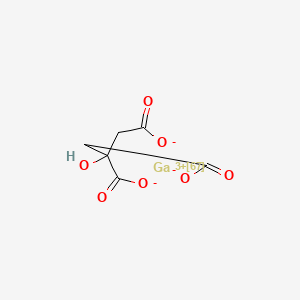



1. 67ga Radioisotope
2. Ga-67 Radioisotope
3. Gallium-67
1. Gallium Citrate Ga 67
2. Gallium-67 Citrate
3. Gallium (67 Ga) Citrate
4. 41183-64-6
5. Gallium (67ga) Citrate
6. Gallium-(sup 67)ga Citrate (1:1)
7. Neoscan
8. Gallium ((sup 67)ga) Citrate
9. Gallium (67ga) Citrate [inn]
10. 4ljk511z86
11. 1,2,3-propanetricarboxylic Acid, 2-hydroxy-, Gallium-(sup 67)ga (1:1) Salt
12. Gallium (67ga) Citrate (inn)
13. (67-ga)gallium Citrate
14. Gallium Citrate (ga67)
15. Einecs 255-248-4
16. Gallii (67 Ga) Citras
17. Gallii (67 Ga) Citras [inn-latin]
18. Citrato De Galio (67 Ga)
19. Citrate De Gallium (67 Ga)
20. Unii-4ljk511z86
21. Citrato De Galio (67 Ga) [inn-spanish]
22. Citrate De Gallium (67 Ga) [inn-french]
23. Gallium Citrate, Ga-67
24. 67ga Radioisotope
25. Neoscan (tn)
26. Ga-67 Radioisotope
27. Gallium 67 Citrate
28. Gallium Citrate,ga-67
29. Gallium Ga-67 Citrate
30. Gallium Citrate Ga 67 [usan:usp:jan]
31. Gallium Citrate (67 Ga)
32. Schembl9754280
33. Gallium Citrate Ga 67 (usp)
34. Gallium-67ga Citrate (1:1)
35. Gallium-67(3+); 2-hydroxypropane-1,2,3-tricarboxylate
36. Chebi:31645
37. Dtxsid70194107
38. Gallium Citrate Ga 67 [mi]
39. Db06784
40. Gallium Citrate Ga 67 [usan]
41. Gallium Citrate,ga-67 [vandf]
42. Gallium (67ga) Citrate [who-dd]
43. Gallium (67ga) Citrate Injection (jp17)
44. Gallium Citrate Ga-67 [orange Book]
45. Gallium Citrate Ga 67 [usp Impurity]
46. D01936
47. Q27260007
48. 1,2,3-propanetricarboxylic Acid, 2-hydroxy-, Gallium-67ga (1:1) Salt
| Molecular Weight | 256.03 g/mol |
|---|---|
| Molecular Formula | C6H5GaO7 |
| Hydrogen Bond Donor Count | 1 |
| Hydrogen Bond Acceptor Count | 7 |
| Rotatable Bond Count | 2 |
| Exact Mass | 255.93173 g/mol |
| Monoisotopic Mass | 255.93173 g/mol |
| Topological Polar Surface Area | 141 Ų |
| Heavy Atom Count | 14 |
| Formal Charge | 0 |
| Complexity | 211 |
| Isotope Atom Count | 1 |
| Defined Atom Stereocenter Count | 0 |
| Undefined Atom Stereocenter Count | 0 |
| Defined Bond Stereocenter Count | 0 |
| Undefined Bond Stereocenter Count | 0 |
| Covalently Bonded Unit Count | 2 |
Gallium Citrate Ga 67 Injection may be useful to demonstrate the presence and extent of Hodgkin's disease, lymphoma, and bronchogenic carcinoma. Positive gallium Ga-67 uptake in the absence of prior symptoms warrants follow-up as an indication of a potential disease state. Gallium Citrate Ga 67 Injection may be useful as an aid in detecting some acute inflammatory lesions.
It has been reported in the scientific literature that following intravenous injection, the highest tissue concentration of gallium Ga-67 - other than tumors and sites of infection - is the renal cortex. After the first day, the maximum concentration shifts to bone and lymph nodes and after the first week, to liver and spleen. Gallium Ga-67 is excreted relatively slowly from the body. The average whole body retention is 65 percent after seven days, with 26 percent having been excreted in the urine and 9 percent in the stools.
V - Various
V09 - Diagnostic radiopharmaceuticals
V09H - Inflammation and infection detection
V09HX - Other diagnostic radiopharmaceuticals for inflammation and infection detection
V09HX01 - Gallium (67Ga) citrate
Absorption
The body generally handles Ga3+ as though it were ferric iron (Fe-III). However, gallium can not be reduced in vivo. Therefore, ferric ion is easily reduced and interacts with protoporphyrin IX to form heme, gallium remains bound to iron-transport proteins and carrier molecules.
Route of Elimination
No urinary excretion; elimination primarily via fecal excretion.
78.26 hours
Gallium Citrate Ga 67, with no carrier added, has been found to concentrate in certain viable primary and metastatic tumors as well as focal sites of infection. The body generally handles Ga3+ as though it were ferric iron (Fe-III), and thus the free isotope ion is bound (and concentrates) in areas of inflammation, such as an infection site, and also areas of rapid cell division. Ga-67 binds to transferrin, leukocyte lactoferrin, bacterial siderophores, inflammatory proteins, and cell-membranes in neutrophils, both living and dead. Lactoferrin is contained within leukocytes. Ga-67 may bind to lactoferrin and be transported to sites of inflammation, or binds to lactoferrin released during bacterial phagocytosis at infection sites (and remains due to binding with macrophage receptors). Ga-67 also attaches to the siderophore molecules of bacteria themselves, and for this reason can be used in leukopenic patients with bacterial infection (here it attaches directly to bacterial proteins, and leukocytes are not needed). Uptake is thought to be associated with a range of tumour properties including transferring receptors, anaerobic tumor metabolism and tumor perfusion and vascular permeability.